Contrasting wine-making styles, personalities and cellar conditions were brought home to me on a recent visit to the Rhône valley.
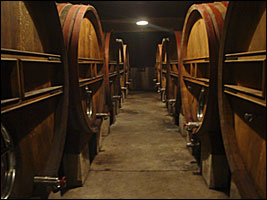
Foudres at Trevallon.
|
We started off at Domaine de Trevallon which is not technically in the Rhone Valley at all. Nor is it officially anywhere else. Eloi Durrbach is somewhat of a maverick and when he planted his vineyard in the mid seventies with 50% Cabernet Sauvignon and 50% Syrah he knew that that this "encepagement" would not be permitted by those who control the appellation laws. So despite being, without doubt, the best wine of the region, Trevallon remains excluded from the local "Les Baux de Provence" appellation.
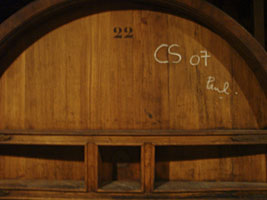
A Cabernet Sauvignon foudre signed by Paul McCartney
|
After starting life as a "VDQS" it is now a simple "Vin de Pays". Not that Eloi cares two hoots about the AC rules. The equal quantities of Syrah and Cabernet here are aged separately in big oak "foudres", one of which was signed by Paul McCartney on a recent visit. The 2007 is still "en foudre" and won't be bottled until January 2010. It's definitely one of the best young Trevallons that I have ever tasted and Eloi compares it with his famous 1982 which, despite being produced from young vines, is the greatest wine that he has ever made. A terrific young wine here and a charming host who also recommended an excellent local restaurant - le Ravi Provencaux.
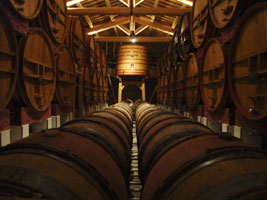
The cellar at Beaucastel.
|
At Chateau de Beaucastel we were greeted by François Perrin who has been in charge here (along with his brother Jean-Pierre) since 1978. Beaucastel is a clean and modern winery but the red wines see no new oak and continue to be made in the traditional manner in giant oak foudres. Francois, like Eloi Durrbach, is genuinely excited about the 2007 vintage which he said was the result of perfect hot days and cool nights. We taste the recently bottled Beaucastel and understand what all the fuss is about. This is a fabulous wine that I think will turn out to be even better than the twin vintages of 1989 and 1990 that I tasted here at a similarly early age and have followed closely ever since (the 1990 is now out-performing the more famous 1989). We also tried the 2007 Coudoulet de Beaucastel which has to be the best Coudoulet ever made. I would happily put this up against most Chateauneuf du Papes. It is a real winner. Later at lunch we tasted the famous Clos des Papes 2007 which was lovely and plump but I would score it a couple of points behind the multi-dimensional Beaucastel.
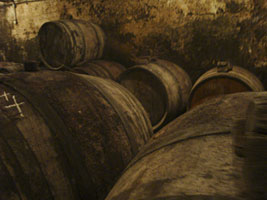
Old wine barrels at Chateau Rayas.
|
From Beaucastel to Rayas it is just a few kilometres but everything about these 2 famous Chateauneuf du Papes is completely different. Beaucastel is made from all 13 permited grape varieties (mainly Mourvedre, Grenache, Syrah and Counoise) on ground so stony that it is impossible to see the earth beneath. Rayas is 100% Grenache and grown on a soil so sandy that it feels almost like walking on a beach. The charming and generous François Perrin is certainly a very different character from Emmanuel Reynaud who looks seriously annoyed to see us despite the fact that one of our party of four is a very famous wine writer and we are bang on time.
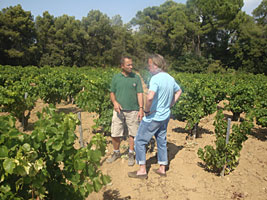
Emmanuel Reynaud and a visitor in the Vineyard.
|
M Reynaud doesn't seem bothered who we are and announces that he's only got 2 wine glasses so we'll just have to share. He asks us if we have time to visit the vineyard before tasting "Yes" we reply eagerly, "Well I haven't" is his response. If that was a joke he hides it well. The first thing I see as we enter the gloomy cellars of Rayas is a large box of rat poison. Now we realise why our host is wearing thick working boots and start to worry about our open-toed sandals - a dangerous choice of footwear at Rayas.
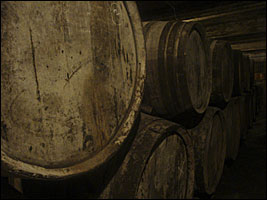
More ancient barrels at Rayas.
|
I try to lighten the mood by asking how often they clean the cellar. "We don't" was the reply "but once a year we wipe away some of the cobwebs". Reynaud tells us how much he hates new oak and proudly tells us that all his barrels are between 30 and 100 years old. They certainly look it and are all absolutely filthy. We fail to work out quite how this estate manages to produce such fine, pure and delicate wine. The 2008 that we are offered today has a lovely strawberry and raspberry flavoured fruit. No, we can't taste the 2007. We say our aurevoirs and dash home to wash our hands.
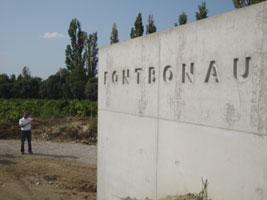
Frederic Engerer beside his newly built modern winery at Fontbonau.
|
Our final visit was to the Northern end of the Southern Rhone where Frederic Engerer of Chateau Latour has just purchased a vineyard a few kilometeres above Valréas with his business partner Jerome Malet. There's lots of old vine Grenache and Syrah here at Fontbonau. The Carignan has already been grubbed up and a vast pile of dead vines awaits the autumn bonfire season. There are also lavender fields, olive groves, truffle trees and a lovely old house with a 17th century sun-dial. Engerer is planning to plant a little Cabernet Sauvignon here that he will bring from you-know-where - though what the Institut National des Appellations d'Origine will make of that he has no idea. A brand spanking new winery is nearing completion with a row of shining stainless steel fermentation tanks and a barrel cellar which will soon be full of barriques that have seen 2 years service at Latour before beginning a new life in the Rhône. Engerer is an enthusiastic host and despite producing one of the world's greatest wines in his day job - he seems like a kid in a sweet shop here. He's certainly brimming with confidence and passion and desperately keen to make the best possible wine in the Côtes du Rhône appellation. With the 2009 grapes looking ripe and healthy on the vines (picking started on September 21st) he's certainly going to have some great raw materials with which to work. More news on the exciting Fontbonau project next year.